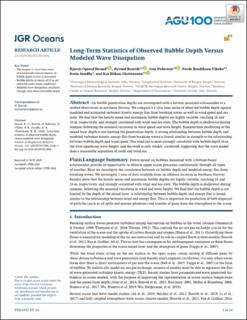| dc.contributor.author | Strand, Kjersti Opstad | |
| dc.contributor.author | Breivik, Øyvind | |
| dc.contributor.author | Pedersen, Geir | |
| dc.contributor.author | Vikebø, Frode Bendiksen | |
| dc.contributor.author | Sundby, Svein | |
| dc.contributor.author | Christensen, Kai Håkon | |
| dc.date.accessioned | 2020-10-15T12:18:00Z | |
| dc.date.available | 2020-10-15T12:18:00Z | |
| dc.date.created | 2020-07-20T14:29:10Z | |
| dc.date.issued | 2020 | |
| dc.identifier.citation | Journal of Geophysical Research (JGR): Space Physics. 2020, 125 (2), . | en_US |
| dc.identifier.issn | 2169-9380 | |
| dc.identifier.uri | https://hdl.handle.net/11250/2683098 | |
| dc.description.abstract | Air bubble penetration depths are investigated with a bottom‐mounted echosounder at a seabed observatory in northern Norway. We compare a 1‐year time series of observed bubble depth against modeled and estimated turbulent kinetic energy flux from breaking waves as well as wind speed and sea state. We find that the hourly mean and maximum bubble depths are highly variable, reaching 18 and 38 m, respectively, and strongly correlated with wind and sea state. The bubble depth is shallowest during summer following the seasonal variations in wind speed and wave height. Summertime shallowing of the mixed layer depth is not limiting the penetration depth. A strong relationship between bubble depth and modeled turbulent kinetic energy flux from breaking waves is found, similar in strength to the relationship between bubble depth and wind speed. The wind sea is more strongly correlated with bubble depth than the total significant wave height, and the swell is only weakly correlated, suggesting that the wave model does a reasonable separation of swell and wind sea. | en_US |
| dc.language.iso | eng | en_US |
| dc.title | Long-Term Statistics of Observed Bubble Depth Versus Modeled Wave Dissipation | en_US |
| dc.type | Peer reviewed | en_US |
| dc.type | Journal article | en_US |
| dc.description.version | publishedVersion | en_US |
| dc.source.pagenumber | 14 | en_US |
| dc.source.volume | 125 | en_US |
| dc.source.journal | Journal of Geophysical Research (JGR): Space Physics | en_US |
| dc.source.issue | 2 | en_US |
| dc.identifier.doi | 10.1029/2019JC015906 | |
| dc.identifier.cristin | 1819881 | |
| dc.relation.project | SIVA: 237906 | en_US |
| dc.relation.project | Norges forskningsråd: 244262 | en_US |
| cristin.ispublished | true | |
| cristin.fulltext | original | |
| cristin.qualitycode | 2 | |
